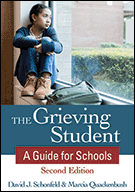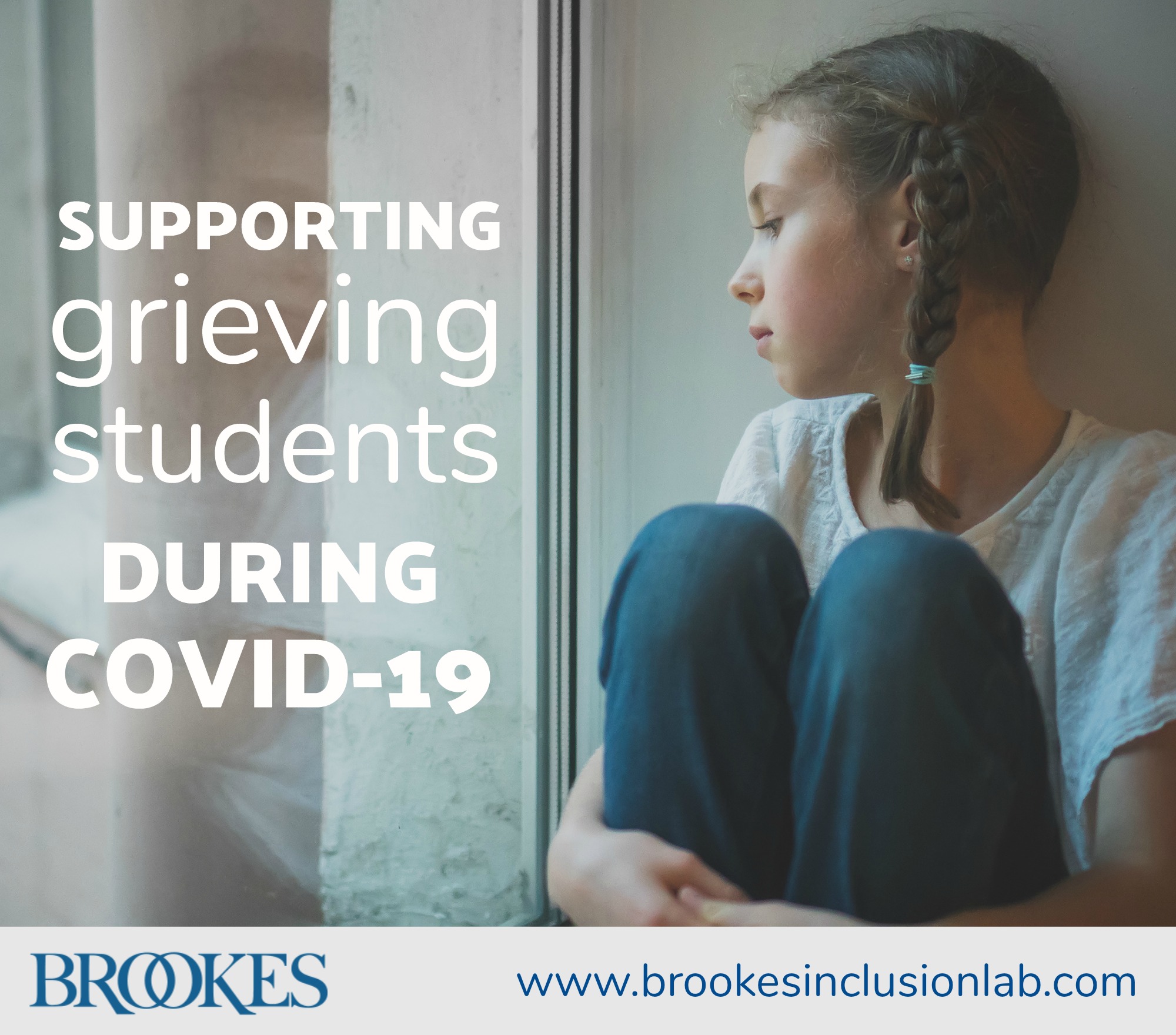In this era of ongoing loss and collective trauma, it’s never been more important for educators to learn how to effectively reach out to and communicate with grieving students. Teachers are often critical sources of support for students, especially those who feel unable to ask questions or express emotions freely at home.
Today’s post offers 8 ways that teachers can open the lines of communication with grieving students—and keep helpful conversations going in the future. Excerpted and adapted from The Grieving Student, a practical guidebook by David Schonfeld and Marcia Quackenbush, these suggestions will help you reach out to students in sensitive ways after a loss in the family or the school community.
Lay the groundwork.
Create an atmosphere that helps students feel they have permission to talk about loss and grief. Show students you are open to discussing difficult topics. Make a habit of listening genuinely—be emotionally and intellectually present during conversations and respond directly to what the student says. Say things like, “You can always ask me about anything, even if it seems like something difficult.” If you lay this groundwork in your classroom, students will have confidence that you are willing to discuss challenging matters and will have something useful to offer them if they approach you for support.
Reach out after a death.
When you hear that a student has experienced a loss, make the commitment to make contact. If you know the student or family well, consider contacting the family at home by phone to offer condolences and support. Even if you don’t know the student well, reaching out to express condolences and acknowledge their loss can be very powerful and helpful. It will also make it much easier for students to return to class when they know that their teachers and other school staff are already aware and ready to provide appropriate support.
Create an opportunity to talk.
It’s usually best if you can find a moment to interact with a grieving student one-to-one—the student could be approached privately before or after class, in common areas of the school, or in some other setting that’s comfortable. You might choose a regular school activity (such as discussing a report or project) that naturally provides one-to-one contact. You could also ask your student to come in a little early or stay after other students have left for a break. If you don’t work directly with the student and don’t have an opportunity for a one-to-one conversation, you can approach the student more generally and express concern. For example, you might approach a student sitting with a couple of friends and say, “It’s good to see you back. You and your family have been in my thoughts.”
Offer condolences and support.
A simple expression of concern and caring lets students know that their teachers are aware of their situation and thinking of them. You might say:
- “I’m sorry to hear about your father.”
- “I just wanted to let you know you’ve been in my thoughts. I am sorry about your brother’s death.”
- “I’m glad to see you back here at school. I was thinking about you while you were at your mom’s funeral.”
- “How are you doing? I’ve been wondering how things have been for you since your grandmother’s death.”
The most important thing to offer in this first contact is a compassionate presence—someone who is willing to provide support if students want or need it. Listen to your students’ responses to your expressions of concern and let them guide you; it’s not necessary to force a discussion. Usually, people who are grieving find it most helpful for someone to listen openly to whatever they have to say.
Beware of unhelpful comments.
Sometimes, comments made with the best of intentions can actually be unhelpful to a grieving student. In an attempt to demonstrate empathy, we may say things like “I know exactly what you are going through” (when that’s not actually possible) or “You must be incredibly angry” (when there’s no way to know what someone else is experiencing at any given time). Avoid comments that may unintentionally minimize or invalidate what your student is feeling. (See this post for a few helpful guidelines on what to say and what not to say to a grieving student.)
Answer students’ questions in simple, age-appropriate ways.
Students may not have opportunities to ask questions at home, particularly if they feel they must protect a grieving parent. Honest, open, and nonjudgmental answers will be most helpful to students. Be mindful about using euphemisms and remember that it is okay, even preferable, to use the terms dead and death. Keep in mind that some questions may need to be answered many times, especially (but not only) with younger children. And sometimes, “I don’t know the answer” is the best response.
Some of your students’ queries may be rhetorical questions about human suffering: “Why do people have to die?” or “Why do we even bother loving people if they’re just going to die?” These questions don’t have concrete answers, but to keep the conversation going, you might respond with comments like these to encourage students to continue expressing their feelings:
- “It’s really hard to understand why these things happen.”
- “So many things about death don’t seem to make any sense at all.”
- “I can only imagine this loss leaves you with a lot of confusion and questions.”
- “You’re asking the questions everyone asks when someone they love dies. It’s hard to make sense of it.”
Check in with other staff members.
Another helpful strategy in maintaining productive communication is to talk with other school staff about their interactions with grieving students. What kinds of contacts are others having with children who are grieving? What are their impressions of how they are coping with loss? What about children who experienced a death some time ago?
Staff members often have distinct perspectives on each student, and they may have new information to share about the ways a child is coping. One educator might have a chance to see more of a student’s strengths and supports, while another might see more of the challenges. Taken together, these observations can often reveal what kind of communication a student might need and who is best suited to offer it. For example, a coach who can talk with a student about his interest in baseball might be the perfect person to make authentic contact about how the student is coping with loss.
Promote ongoing communication.
Students’ thoughts, insights, and feelings change over time. Many will appreciate ongoing opportunities to talk about the ways their experiences are changing. Students who are interested in talking more may ask questions, talk about their experiences, or keep the conversation going in other ways. To help keep the lines of communication open, you can check in with open-ended questions such as:
- “How have you been doing over the past couple of weeks?”
- “How’s your mom (sister, brother, family) doing?”
- “What’s it like coming back to school?”
- “What has this past week been like for you?”
- “What sorts of things are you thinking about these days?”
Keep these important tips and insights in mind as you work with students during the ongoing pandemic and beyond. And for a more in-depth guide to providing effective support to grieving students of all ages and their families, add the book behind today’s post to your professional library.

The Grieving Student
A Guide for Schools, Second Edition
By David Schonfeld, M.D., FAAP, & Marcia Quackenbush, M.S., MFT, CHES
Author David Schonfeld—a renowned expert on childhood bereavement and school crisis—partners with family therapist Marcia Quackenbush to guide school teams through a child’s experience of grief and illuminate the most powerful ways to make a positive difference. School staff will get real-world tips, strategies, vignettes, and activities to help them skillfully support students as they cope with grief and work their way back to full participation in academic and social life.
Stay up to date on the latest posts, news, strategies, and more!
Sign up for one of our FREE newslettersMore posts like this

Author Q&A: David Schonfeld and Marcia Quackenbush on the new edition of The Grieving Student
March 2, 2021
GUEST POST: Supporting Grieving Students During the COVID-19 Pandemic
September 2, 2020


Write a Comment
Your email address will not be published. Required fields are marked *
Post a Comment